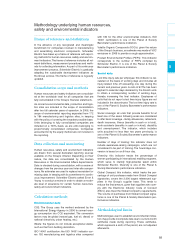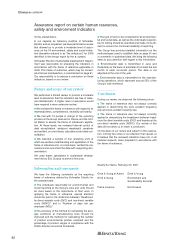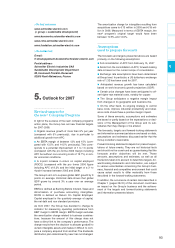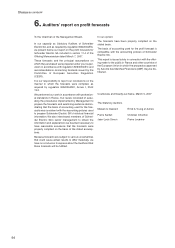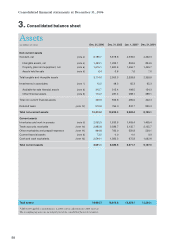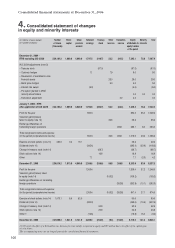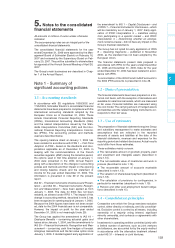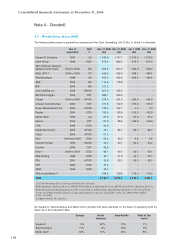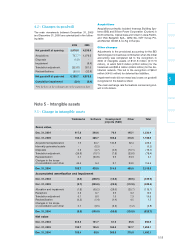APC 2006 Annual Report Download - page 103
Download and view the complete annual report
Please find page 103 of the 2006 APC annual report below. You can navigate through the pages in the report by either clicking on the pages listed below, or by using the keyword search tool below to find specific information within the annual report.
5. Notes to the consolidated
financial statements
All amounts in millions of euros unless otherwise
indicated.
The accompanying notes are an integral part of the
consolidated financial statements.
The consolidated financial statements for the year
ended December 31, 2006 were approved by the Man-
agement Board of Schneider Electric on February 16,
2007 and reviewed by the Supervisory Board on Feb-
ruary 20, 2007. They will be submitted to shareholders
for approval at the Annual General Meeting of April 26,
2007.
The Group’s main businesses are described in Chap-
ter 1 of the Annual Report.
Note 1 - Summary of
significant accounting policies
1.1 - Accounting standards
In accordance with EU regulations 1606/2002 and
1725/2003, Schneider Electric’s consolidated financial
statements have been prepared in compliance with the
international accounting standards adopted by the
European Union as of December 31, 2006. These
include International Financial Reporting Standards
(IFRSs), International Accounting Standards (IASs)
and the related interpretations issued by the Stan-
dards Interpretations Committee (SIC) and the Inter-
national Financial Reporting Interpretations Commit-
tee (IFRIC). The accounting policies and methods
used are described below.
The opening balance sheet at January 1, 2004 has
been restated in accordance with IFRS 1 –
First-Time
Adoption of IFRS
– based on the standards and inter-
pretations applicable as of December 31, 2005. In
keeping with the recommendations of the French
securities regulator (AMF) during the transition period,
the options used in first time adoption at January 1,
2004 were presented in the 2004 Annual Report,
along with a description of the changes in accounting
policies and methods and their impact on the opening
and closing balance sheets and the statement of
income for the year ended December 31, 2004. This
information is presented in note 29 of the present
report.
IAS 32 –
Financial Instruments: Disclosure and Presen-
tation
– and IAS 39 –
Financial Instruments: Recogni-
tion and Measurement
– have been applied as from
January 1, 2005. The data for 2004 has not been
restated, as allowed under IFRS 1. The impact of this
change in accounting method, described in note 2, has
been recognized in opening equity at January 1, 2005.
Because the 2004 figures have been not been restat-
ed, data for the 2004 financial year is not comparable.
However, the impact on profit for the year ended
December 31, 2005 is not meaningful (note 29).
The Group has applied the amendment to IAS 19 –
Employee Benefits
– concerning actuarial gains and
losses since January 1, 2004, and the amendments to
IAS 39 –
Financial Instruments: Recognition and Mea-
surement
– concerning cash flow hedges of forecast
intragroup transactions and the fair value option since
January 1, 2005. It decided against early application of
the amendment to IAS 1 –
Capital Disclosures
– and
of IFRS 7 –
Financial Instruments: Disclosures
– which
will be mandatory as of January 1, 2007. Early appli-
cation of IFRIC interpretation 6 –
Liabilities arising
from participating in a specific market
– and IFRIC
interpretation 4 –
Determining whether an arrange-
ment contains a lease
– did not have any impact on the
Group’s financial statements.
The Group has not opted for early application of IFRS
8 –
Operating Segments
– published in November
2006, as the standard has not been adopted by the
European Union.
The financial statements present data prepared in
accordance with IFRS for the years ended December
31, 2006 and December 31, 2005. Data for the year
ended December 31, 2004 has been restated in accor-
dance with IFRS.
A reconciliation of the 2004 French GAAP accounts to
the 2004 IFRS accounts is presented in note 29.
1.2 - Basis of presentation
The financial statements have been prepared on a his-
torical cost basis, with the exception of derivatives and
available-for-sale financial assets, which are measured
at fair value. Financial liabilities are measured using
the cost model. The carrying amount of hedged assets
and liabilities and the related hedging instruments cor-
responds to their fair value.
1.3 - Use of estimates
The preparation of financial statements requires Group
and subsidiary management to make estimates and
assumptions that are reflected in the reported
amounts of assets and liabilities at the date of the
financial statements, revenues and expenses for the
reporting period and related disclosures. Actual results
could differ from those estimates.
These estimates mainly concern:
The recoverable amount of goodwill, property, plant
and equipment and intangible assets (described in
note 1.10).
The net realizable value of inventories and work in
process (described in note 1.12).
The recoverable amount of accounts receivable
(described in note 1.13).
The valuation of share-based payment (described in
note 1.18).
The calculation of provisions for contingencies, in
particular for warranties (described in note 1.19).
Pension and other post-employment benefit obliga-
tions (described in note 15).
1.4 - Consolidation principles
Companies over which the Group exercises exclusive
control, either directly or indirectly, are fully consolidat-
ed. Exclusive control is control by all means, including
ownership of a majority voting interest, significant
minority ownership, and contracts or agreements with
other shareholders.
Investments in operating entities controlled jointly with
a limited number of partners, such as joint ventures
and alliances, are accounted for by the equity method
in accordance with the alternative treatment allowed
under IAS 31 –
Interests in Joint Ventures.
101
5


